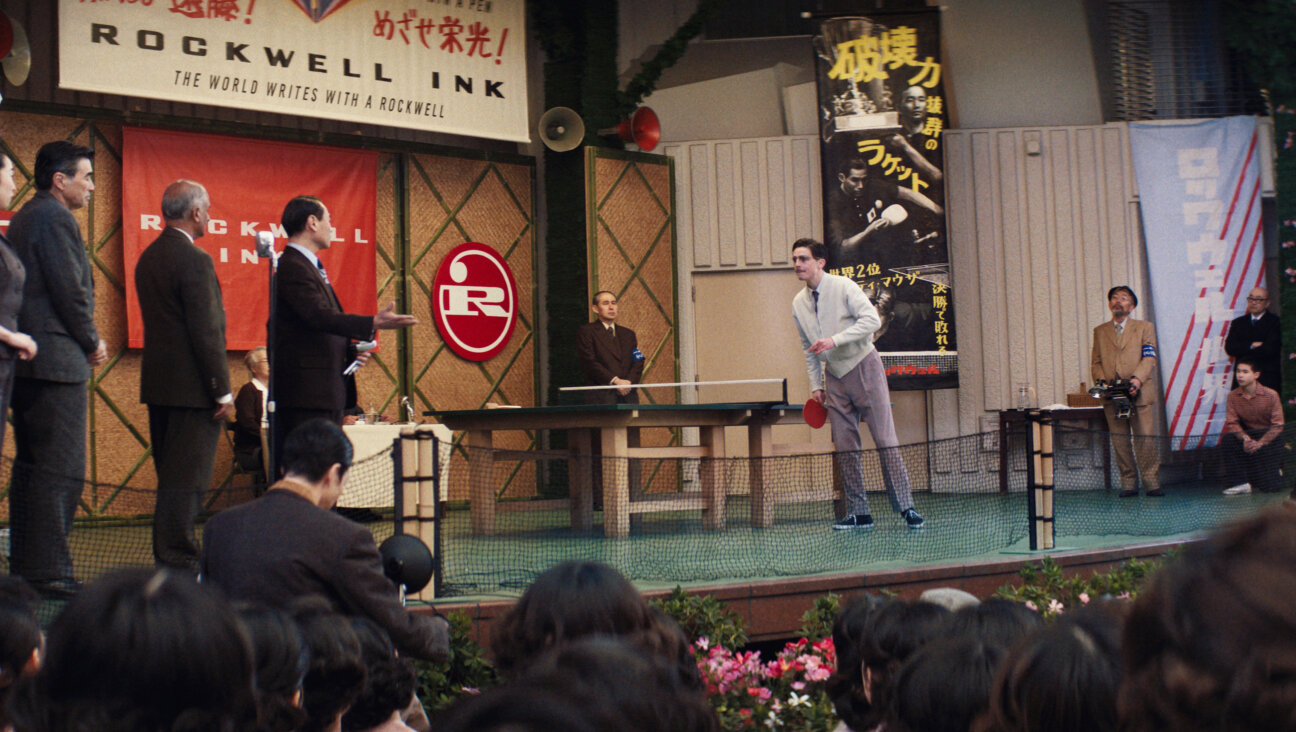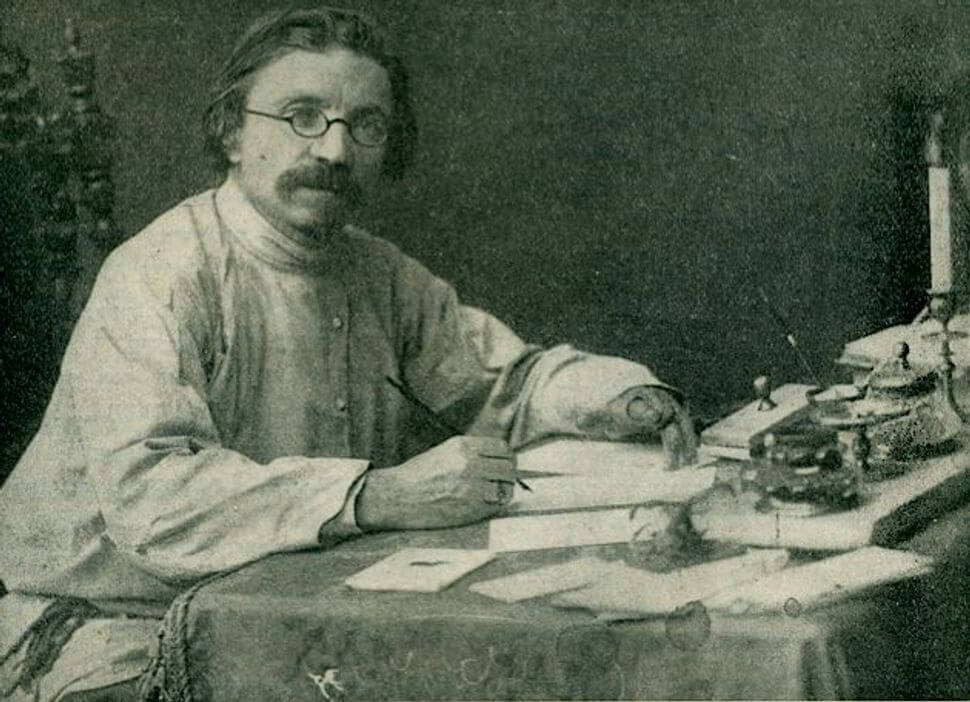You see an ugly ottoman or a faded armchair; she sees a lost history waiting to be revived
For Ruti Wajnberg, a granddaughter of Holocaust survivors, reupholstering furniture can stitch generations back together
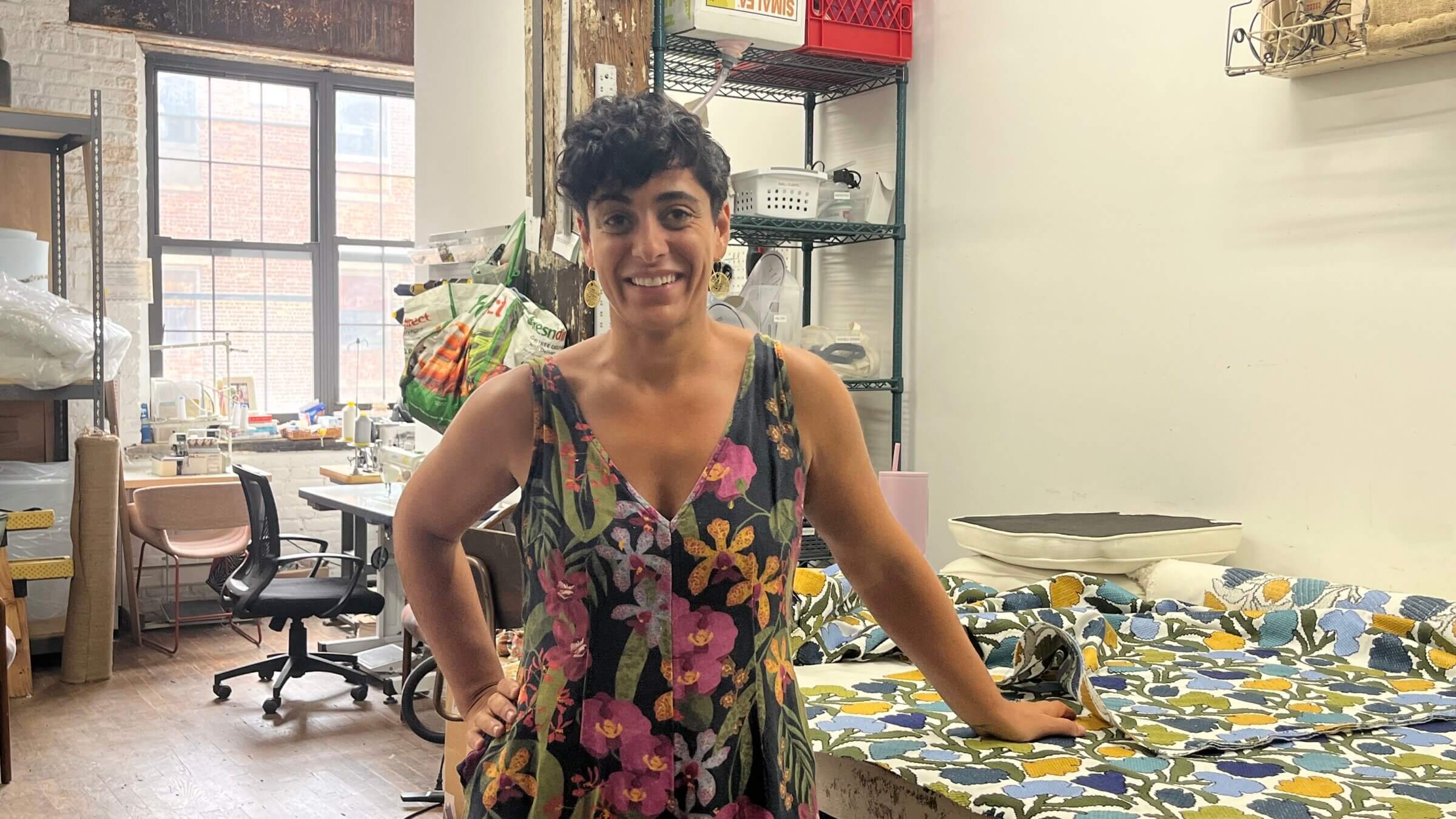
Ruti Wajnberg in her Brooklyn studio. Photo by Getty Images
Even when she was a little kid, Ruti Wajnberg knew her grandma’s brown ottoman was ugly. She loved it anyway. Whenever she and her sisters would make the trek from New Jersey to visit their grandmother in Brighton Beach, they would roll around on the mushroom-shaped seat.
“It’s in all my memories of her apartment,” Wajnberg told me at her upholstery studio in Brooklyn. “It was my grandma’s, it’s tied up with my memories of her, and I wish I had it.”
To be clear, the brown would have to go. “I would have ripped that fabric off that stool so fast,” said Wajnberg, 41, a former product manager and software developer who started her reupholstery business Find the Thread two years ago to give new life to old furniture. “It would be so meaningful to me to have it, to watch my kids roll on it; that would bring me to tears.”
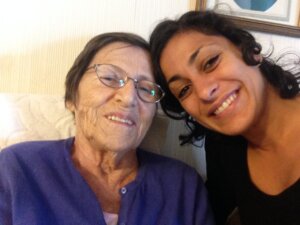
As the granddaughter of Holocaust survivors and the daughter of Jews who were expelled from Communist Poland in 1968, Wajnberg doesn’t have many heirlooms. More than once, her family has been forced to leave everything behind — including, in her grandparents’ cases, the loved ones who perished at the hands of the Nazis.
When Wajnberg’s parents fled Poland as teenagers — her mother’s family to Israel and her father’s to New York via Italy — they could take very little with them. Her mother told her she’d tucked a portrait a friend had painted of her in her suitcase. It was confiscated.
“That always struck me as so sad, that experience of just arriving completely empty-handed,” said Wajnberg, who wrote her undergrad thesis at NYU about her family history. This sense of loss is part of what drew her to saving and reviving furniture imbued with personal meaning.
“I don’t have that line of connection to anything in the past. I don’t have photographs of my great grandparents, anything that belonged to them,” she said. “Possessions carry a lot of stories. They’re a reason to talk about the person and remember them.”
As ugly as the brown ottoman may have been, she wishes she’d had the foresight to ask for it when her grandmother — who was her “bestie” when she was young — died in 2016. “When we go to Brighton Beach, I talk about my grandparents, because I’m in their space,” she said. “But I’m never in their space in my space.”
These days, people come to her with all kinds of projects: thrift finds that need zhuzhing, built-in window seats that require oddly shaped cushions, salvaged church pews that could use dressing up, fabric purchased on vacation that they want to put to use, faded furniture they don’t want to part with, and pieces they inherited.
“Most often I get, ‘This was my grandma’s,’” she said. “That’s my favorite. If it was your grandma’s, I’m in.”
Finding the thread
The first thing Wajnberg ever upholstered, coincidentally, was an ottoman. “I found an upholstery class in the East Village that sadly doesn’t exist anymore, and I signed up for it, having no idea that I would like it. I just wanted a creative outlet,” said Wajnberg, who was working as a product manager at the time. She still has the ottoman she made from scratch. Looking back with a more expert eye, she said, “it’s not very well-made.” But she loved the process. The tactile, physical experience reminded her of the time she spent working in the garden on a kibbutz in Israel, and she craved more of it.
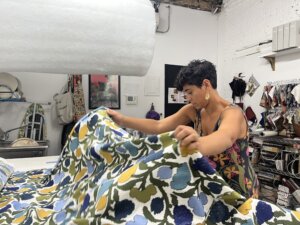
Like many first-generation Americans growing up with immigrant parents, Wajnberg didn’t always imagine this path. “The idea of an artistic life or career was not really presented as an option,” said Wajnberg, the third of four girls. Music was a huge part of her childhood in New Jersey — all the kids played piano and another instrument and sang in choirs — and she always loved making things. But the arts felt more like “a hobby option.”
“My parents understandably had this feeling that nothing that you have is yours, except for your education,” she said. “People can take your stuff and people can take your passport, and the only thing you really have is your brain.”
Wajnberg started college at NYU thinking she’d study journalism, but quickly switched to history, and interned at the Museum of Jewish Heritage. After graduation, she moved to Israel to work on a kibbutz for six months and spend time with her other grandparents in Tel Aviv. She ended up staying for three years, earning an MBA from Reichman University and taking on her first jobs in tech.
When she returned to the States, Wajnberg worked as a product manager and later pivoted to become a software developer. All the while, she kept up her upholstery hobby. After her first son was born, she remembered, she’d often put him to sleep, then head down to the unfinished basement of their building, “and just rip things up and put them back together.” She was taking online courses, watching YouTube videos, and traveling occasionally for courses wherever she could find them.
“I just knew I loved it. But I also liked my job,” she said. “I fantasized about being an upholsterer and I would meet women my age-ish who had their own shop, and it just felt so unattainably cool to me and not really a practical option,” she said. “I really had to work to shed the practicality of what I thought I needed to be doing.”
Then the pandemic hit. Wajnberg had just had her second son and when she returned from leave in the midst of lockdown, she realized she didn’t like working remotely, without the human interactions that were her favorite part of the job. She went down to four days a week so she could work Fridays at the Brooklyn upholstery studio Stitchroom.
“After a couple of weeks, I was just like, ‘This is all I can think about. This is all I want to do,’” she said. She parlayed it into a full-time job as the shop’s head of production. Three years in, she felt ready to open up a shop of her own.
‘Making things’
Wajnberg’s studio is nestled on the third floor of a building with office lofts and artist spaces across from the Brooklyn Navy Yard. A window in the back corner spills natural light onto a small desk and three sewing machines. Up front there’s a large worktable and a couple projects in progress pushed against the sides of the space. On the day I visited, there was a Victorian sofa half-dressed in yellow, green and blue flowers, and a chair waiting to be adorned in gold chenille.
Her apron, hanging by the door, is covered in leaves and flowers, a cheerful mess of reds, yellows, oranges, pinks, and greens. “I, you may have noticed, am a floral gal,” she said.
“They make me smile. They make me happy. They make me feel lighter,” she added. “I just want to be drenched in flowers while I upholster things in flowers.”
The jubilant fabrics and the warmth of Wajnberg’s personality belie what has been, in some ways, a difficult first chapter. “I’ve really only had this business in times of great pain,” Wajnberg said. She started Find the Thread in September 2023, just weeks before the Hamas attacks on Oct. 7. “I have a lot of people there,” she explained, people she loves and worries about in Israel, including all of her family on her mother’s side and friends she made while living there. “It’s painful, regardless of what your political beliefs are.”
“Like many people who come from a lineage of trauma, I have a very busy, anxious mind,” Wajnberg said. “And I really feel centered and calmer when I’m working with my hands.” To offer others the same kind of outlet — and an introduction to upholstery — she’s been giving monthly classes in her studio, teaching participants to make throw pillows or reupholster one of their own dining room chairs.
“People are really craving tactile accomplishment,” she said. At the end of each workshop, when everyone pauses and looks at what they’ve created, “there’s this real sense of pride in the room. Like, ‘I made this, I just made this thing with my hands,’” she said. “It feels so good.”
Reviving and renewing
There’s an armchair that’s been sitting in Linda Ellman’s living room in Brooklyn for decades. It was there when her two daughters were growing up, and it’s there now when her four grandchildren come over after school — the perfect cozy spot to cuddle up and read together. It always conjured up memories of a similar chair that Ellman used to sit in to read with one of her parents or her grandma when she was a kid.
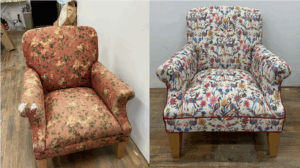
“One of the important things we do with children is we hold them close, we read things to them that help them think about themselves and the world,” Ellman, a retired teacher, told me over the phone. “I’m continuing the tradition. I lived near both my grandparents and they were very much in my life, and these kids are very much in my life.”
When the fabric started falling apart, Ellman considered buying a new chair. But she was attached to the chair she already had and the many years of memories it held. So she decided to reupholster it instead, and a friend referred her to Wajnberg.
After prospective clients reach out for an initial quote, the first step is fabric selection. Wajnberg works primarily with “regular people,” rather than interior designers and other industry professionals, so she often has to guide them to figure out what they want. “I think I’ve gotten really good at pulling other people’s style out of them,” she said.
At first, she’d ask people what they were looking for and bring samples to them. Until she realized most people have no idea. Now they usually come to her studio, so she can observe their reactions closely and pull from her entire library. They may think they want one thing, and ultimately fall in love with something else. Ellman, for instance, was looking for a romantic floral pattern to echo the muted red fabric she’d had, but ended up with a bright jungle print.
“You can always say no later, so this is the moment to push yourself out of your comfort zone and have fun and explore,” said Wajnberg, who sends clients swatches so they can put them in the room, mull it over, solicit opinions, “let their pet play with it and see if they can destroy it,” and “come to a leisurely decision.” And, she said, “if you get home and you want beige, you get beige.”
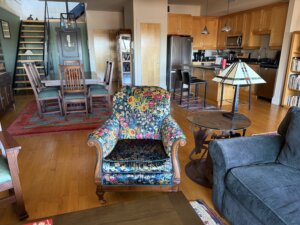
Judy Mann was looking for green. Her armchair had been fading in the sun. “It was going from this magnificent pattern to kind of grayish nothing,” she told me on Zoom. She turned to Wajnberg, her neighbor, for help. “She’s warm and charming and has a sparkle to her,” said Mann, who is the retired COO of Jewish Funders Network.
Mann’s armchair project cost around $2,300, including about $800 in labor costs. It was more than she’d intended to pay to replace or refresh her chair, mostly because of the pricey fabric. According to Wajnberg, people often underestimate the cost compared to the now-ubiquitous fast furniture. Reupholstering a simple dining chair might run $100, while a complex sofa might be $4,000 or $5,000. But Ruti “conveys confidence,” Mann said. “So if I was gonna spend this kind of money, I was quite sure it was going to be worthwhile.”
Together, Mann and Wajnberg selected an arresting pattern of colorful, overgrown flowers — “wild meadow free spirit vibes,” as Wajnberg put it on Instagram. It was a departure from the green “tribal” pattern of the original chair but still fit the color scheme. “It ended up being way better than I imagined,” Mann said.
“It’s extraordinarily beautiful, in my opinion,” she said. “I’m always shocked if someone comes in and doesn’t comment about the chair.”
For Mann, Ellman, and others who have a sentimental attachment to the furniture they bring her, Wajnberg has a surprise: She makes them a small pillow out of the original fabric. “Oftentimes it’s the fabric underneath the cushion or somewhere out of the way that reveals the true color,” she said. “I’ll try to find a piece that’s vibrant, which I think is really emotional for people, because sometimes they haven’t seen it that way in so long.”
In the two years since Wajnberg started Find the Thread, she’s reupholstered everything from a settee inherited from a late grandfather’s vintage store to the chairs at Pitt’s, a new Red Hook restaurant by Agi’s Counter chef Jeremy Salamon, to a neighbor’s grandparents’ Torah scroll.
Wajnberg can’t say for sure that this is the final stop on her winding career path, but right now, it feels right. “I feel so much more like I’m part of this humming local economy than I used to when I was making things on the internet that faraway people would use,” she said.




